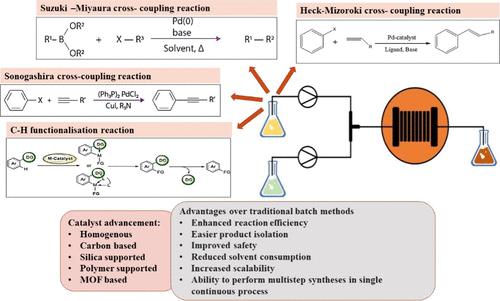催化进展:通过流动化学优化钯基交叉偶联反应
IF 3.5
3区 化学
Q2 CHEMISTRY, APPLIED
引用次数: 0
摘要
流动化学是一种通过泵将反应物泵入系统,在连续流动的通道中进行反应的方法。与间歇式反应相比,这种先进的方法可提供快速高效的混合、反应条件的精确控制、高通量筛选以及反应的快速优化。当前,人们正在利用流动化学高效生产各种医药中间体。其中最重要的反应之一是使用过渡金属催化(尤其是钯)的碳-碳交叉偶联反应。交叉偶联反应对于创造具有制药、农用化学品和精细化学品所需定制特性的先进材料至关重要。多年来,人们探索并广泛应用了许多钯催化交叉偶联反应,如 Suzuki-Miyaura 偶联、Mizoroki-Heck 偶联、Sonogashira 偶联、Stille 偶联、Negishi 偶联等。通过使用填料床反应器将分离过程整合为一个步骤,并省去了催化剂回收的额外步骤,异相催化的连续流方法增强了反应的效果。本综述的重点是讨论在流动反应中为钯催化交叉偶联反应开发的各种催化剂,并对其进行优化,如流速、停留时间、温度、钯载量、溶剂、碱和起始材料的浓度等。本综述全面研究了这些用于流动化学 C-C 偶联反应的催化剂。本文章由计算机程序翻译,如有差异,请以英文原文为准。

Catalytic Advancements: Optimizing Pd-Based Cross-Coupling Reactions Through Flow Chemistry
Flow chemistry is a method of conducting a reaction in continuous flow through channels by pumping the reactants into the system. This advanced method offers rapid and efficient mixing, precise control of reaction conditions, high-throughput screening, and rapid optimization of the reaction as compared to batch conditions. In the current times, various pharmaceutical intermediates are being produced efficiently using flow chemistry. One of the most important reactions emerging is the carbon–carbon cross coupling reaction using transition metal catalysis especially palladium. Cross-coupling reactions are vital in the creation of advanced materials with tailored properties desired for pharmaceuticals, agrochemicals, and fine chemicals. Over the years, numerous Pd-catalyzed cross-coupling reactions, such as Suzuki-Miyaura coupling, Mizoroki-Heck coupling, Sonogashira coupling, Stille coupling, Negishi coupling, etc., have been explored and widely applied. Continuous-flow methods for heterogeneous catalysis have enhanced the reaction by integrating the separation process into a single step using packed bed reactors and eliminating the need for additional steps for catalyst recovery. The focus of this review is to address various catalysts developed for Pd-catalyzed cross-coupling reactions in a flow reaction, followed by optimization such as flow rate, residence time, temperature, Pd loading, solvent, base, and concentration of starting material. This review presents a comprehensive study of these catalysts used for C–C coupling using flow chemistry.
求助全文
通过发布文献求助,成功后即可免费获取论文全文。
去求助
来源期刊
CiteScore
6.90
自引率
14.70%
发文量
251
审稿时长
2 months
期刊介绍:
The journal Organic Process Research & Development serves as a communication tool between industrial chemists and chemists working in universities and research institutes. As such, it reports original work from the broad field of industrial process chemistry but also presents academic results that are relevant, or potentially relevant, to industrial applications. Process chemistry is the science that enables the safe, environmentally benign and ultimately economical manufacturing of organic compounds that are required in larger amounts to help address the needs of society. Consequently, the Journal encompasses every aspect of organic chemistry, including all aspects of catalysis, synthetic methodology development and synthetic strategy exploration, but also includes aspects from analytical and solid-state chemistry and chemical engineering, such as work-up tools,process safety, or flow-chemistry. The goal of development and optimization of chemical reactions and processes is their transfer to a larger scale; original work describing such studies and the actual implementation on scale is highly relevant to the journal. However, studies on new developments from either industry, research institutes or academia that have not yet been demonstrated on scale, but where an industrial utility can be expected and where the study has addressed important prerequisites for a scale-up and has given confidence into the reliability and practicality of the chemistry, also serve the mission of OPR&D as a communication tool between the different contributors to the field.

 求助内容:
求助内容: 应助结果提醒方式:
应助结果提醒方式:


